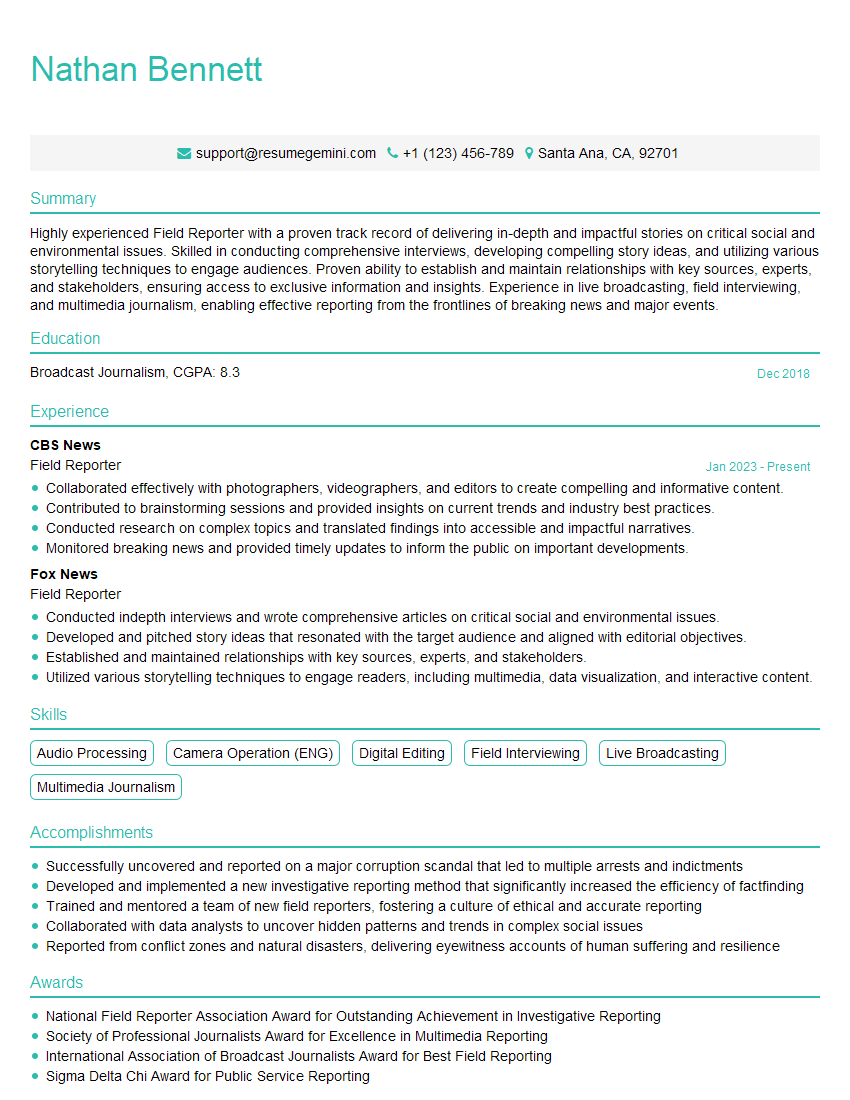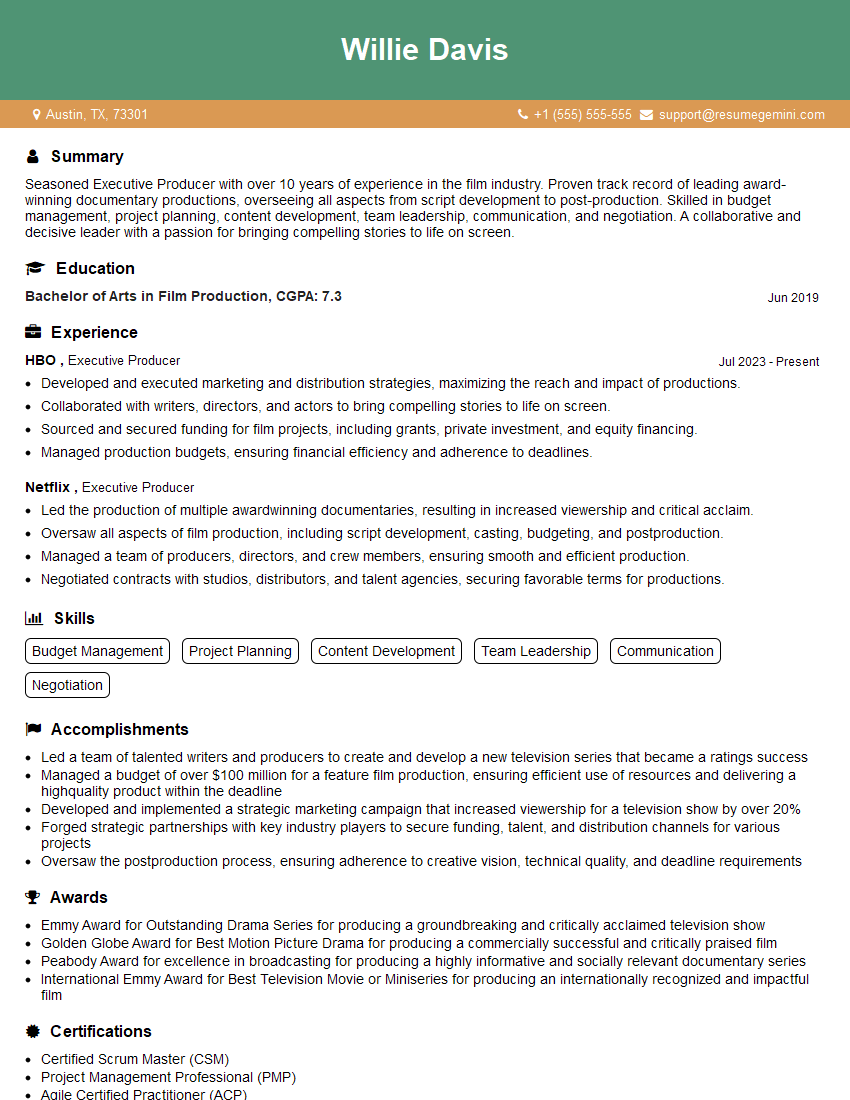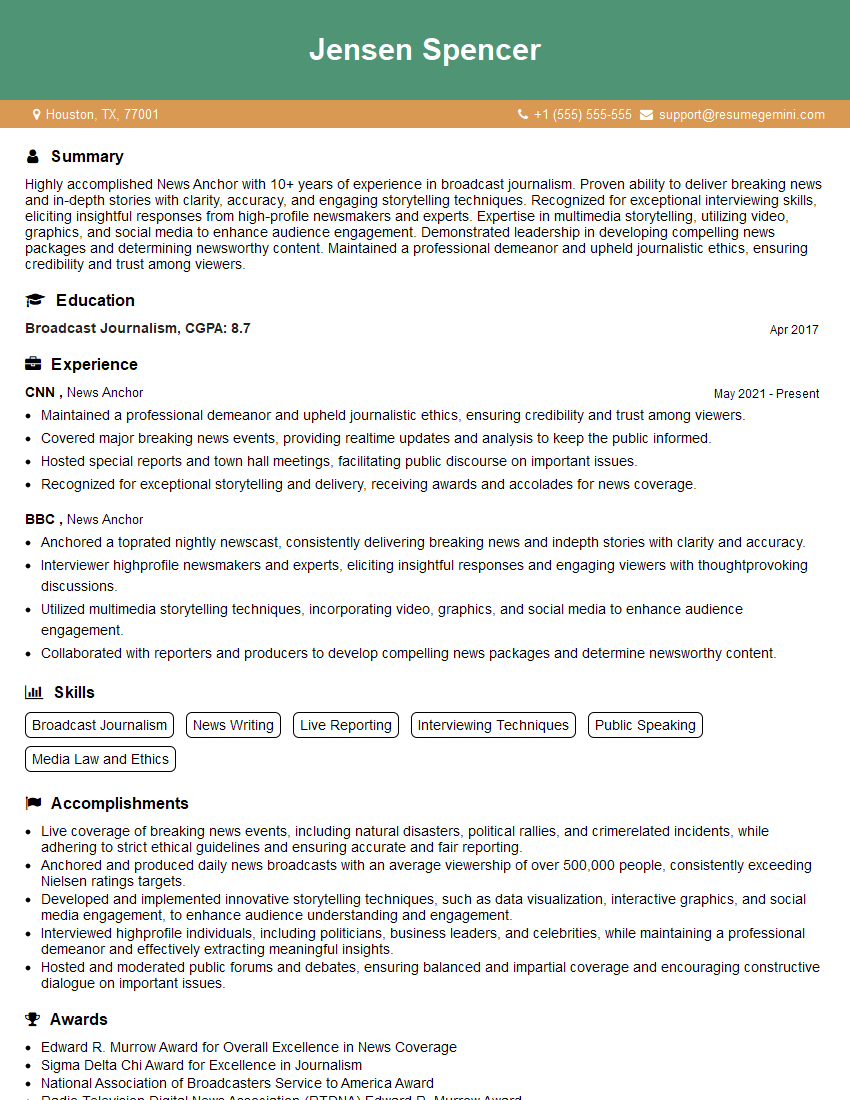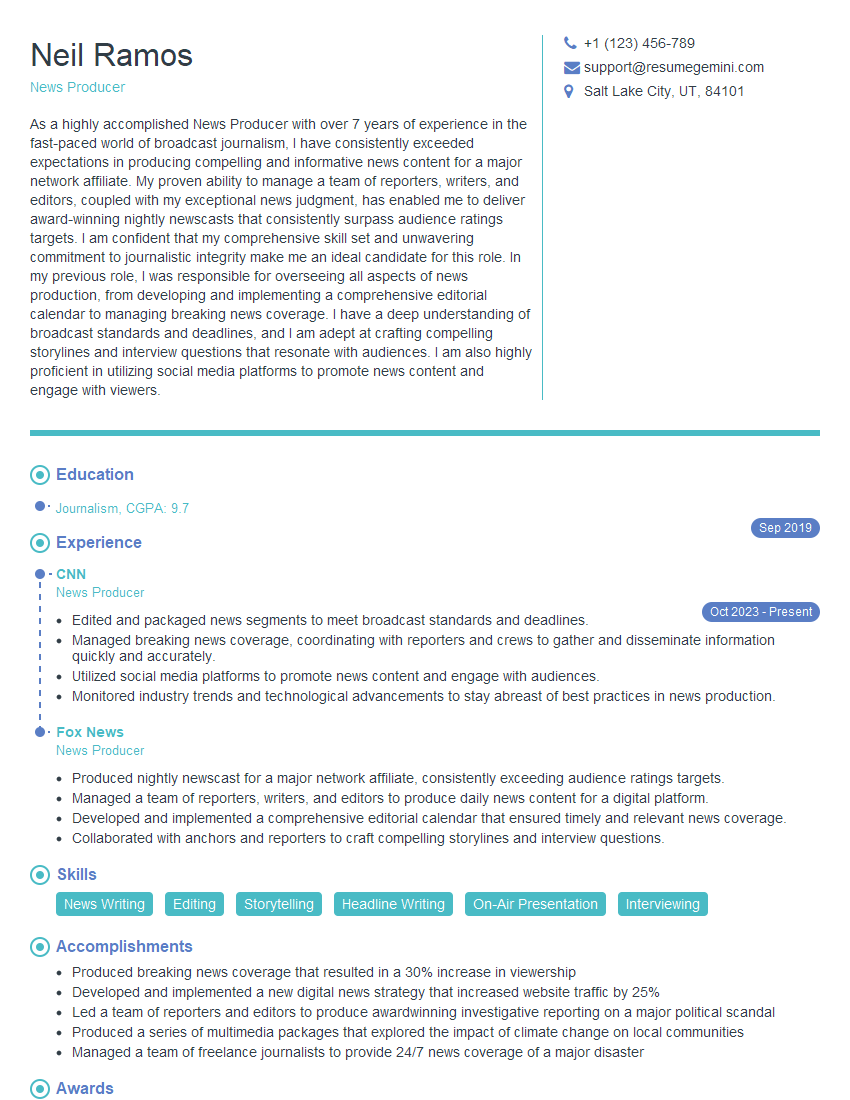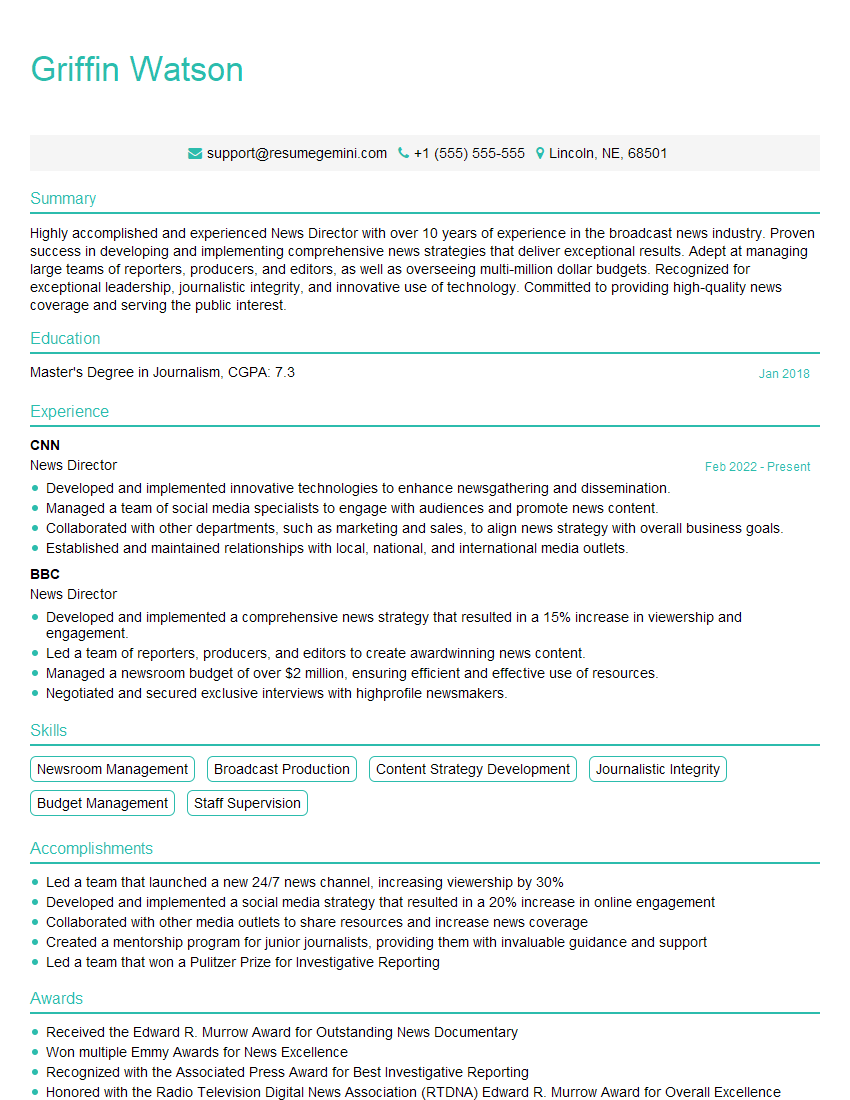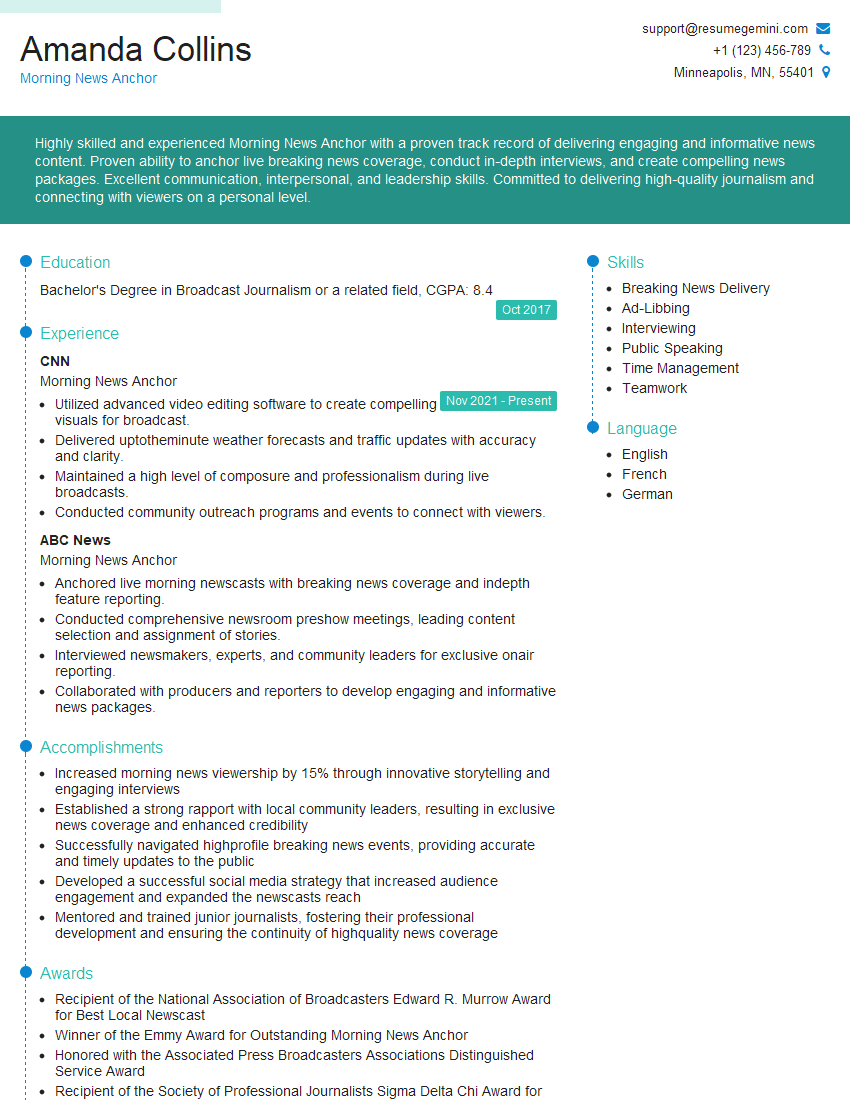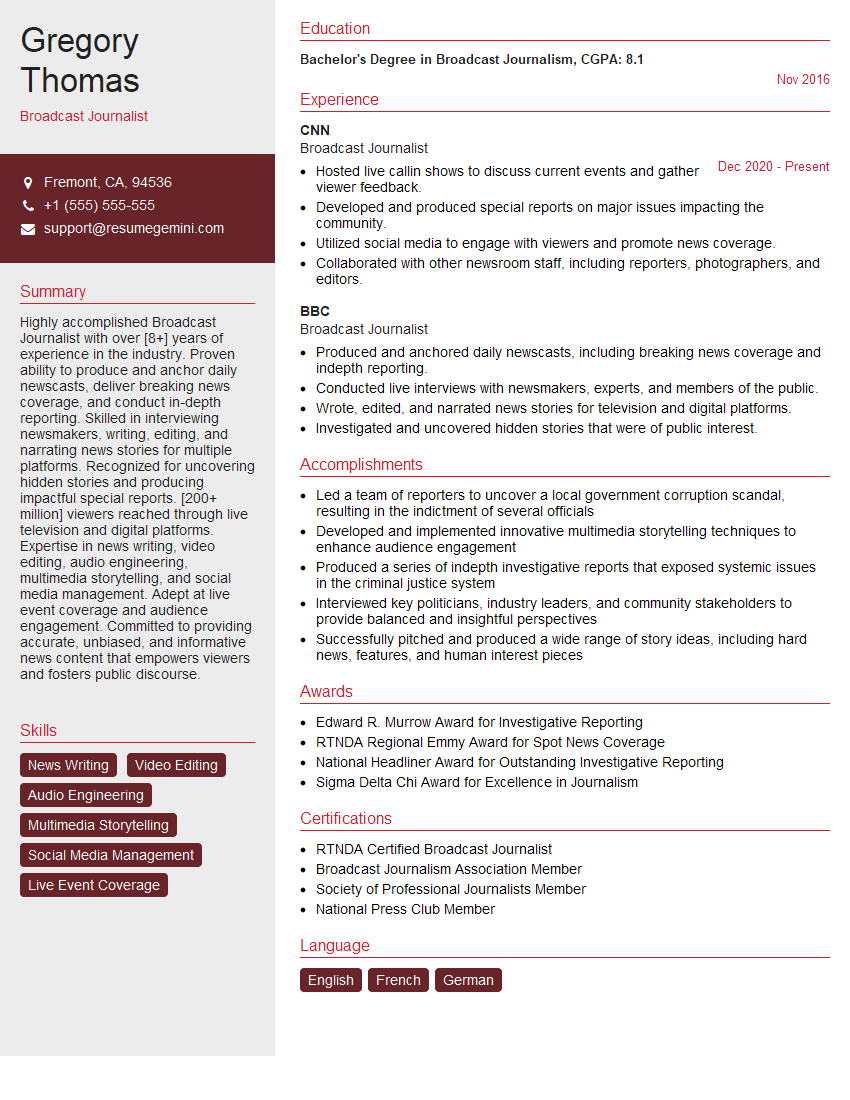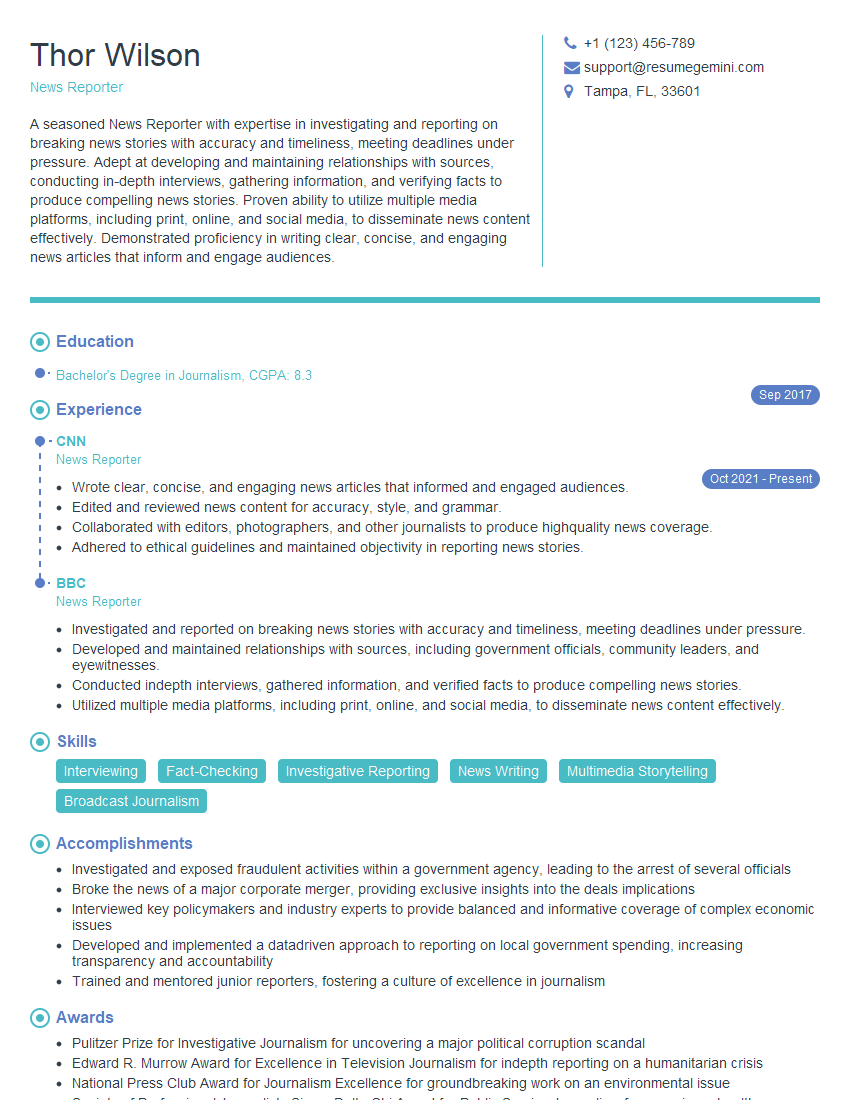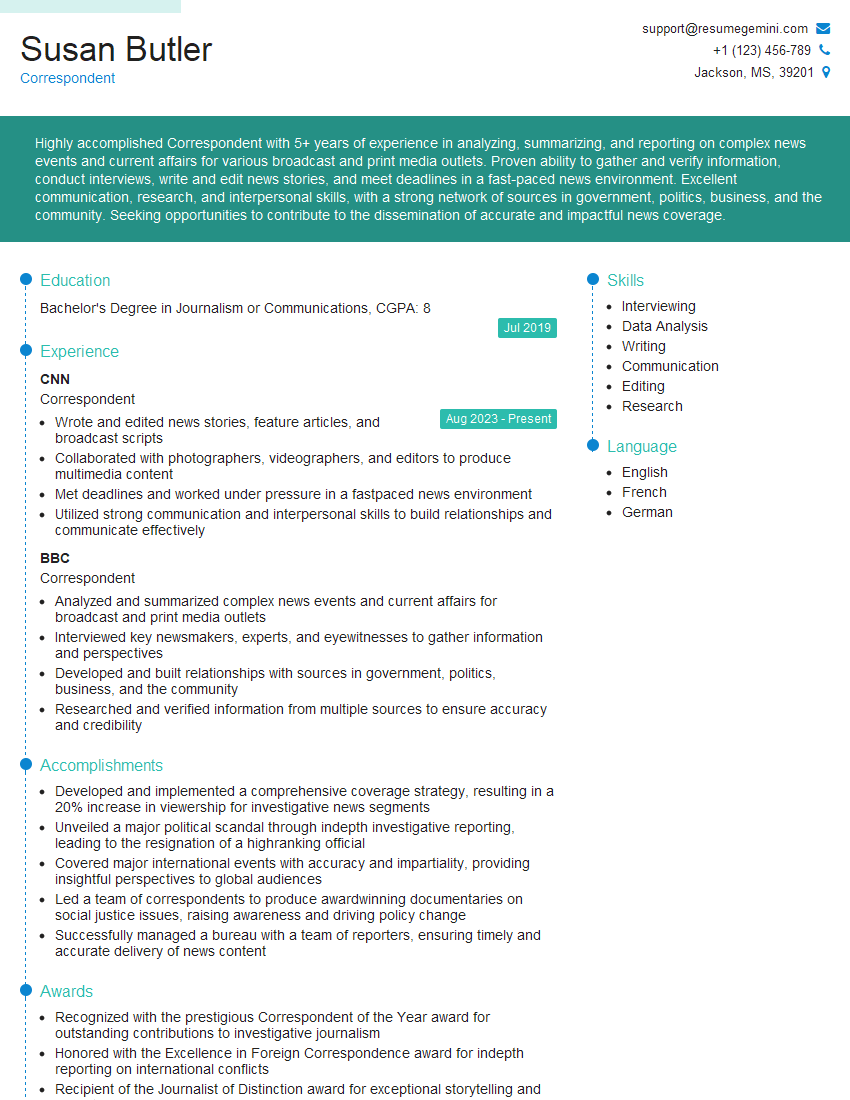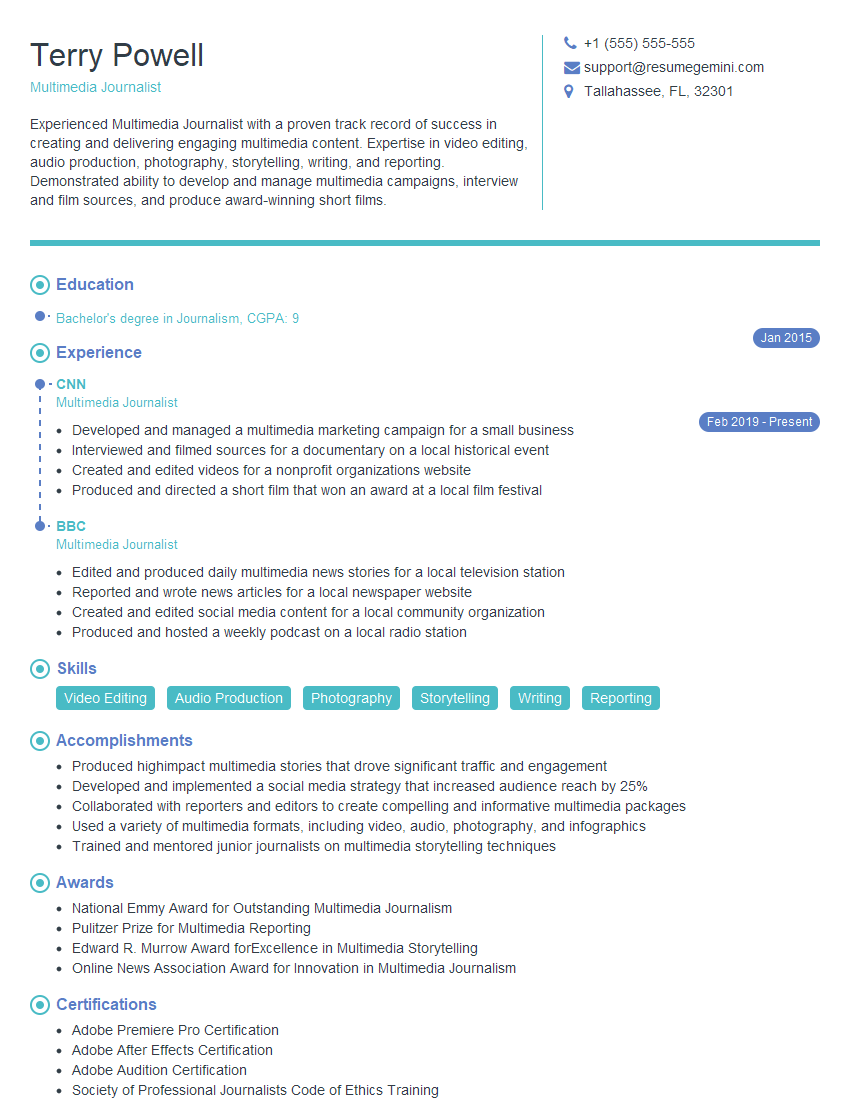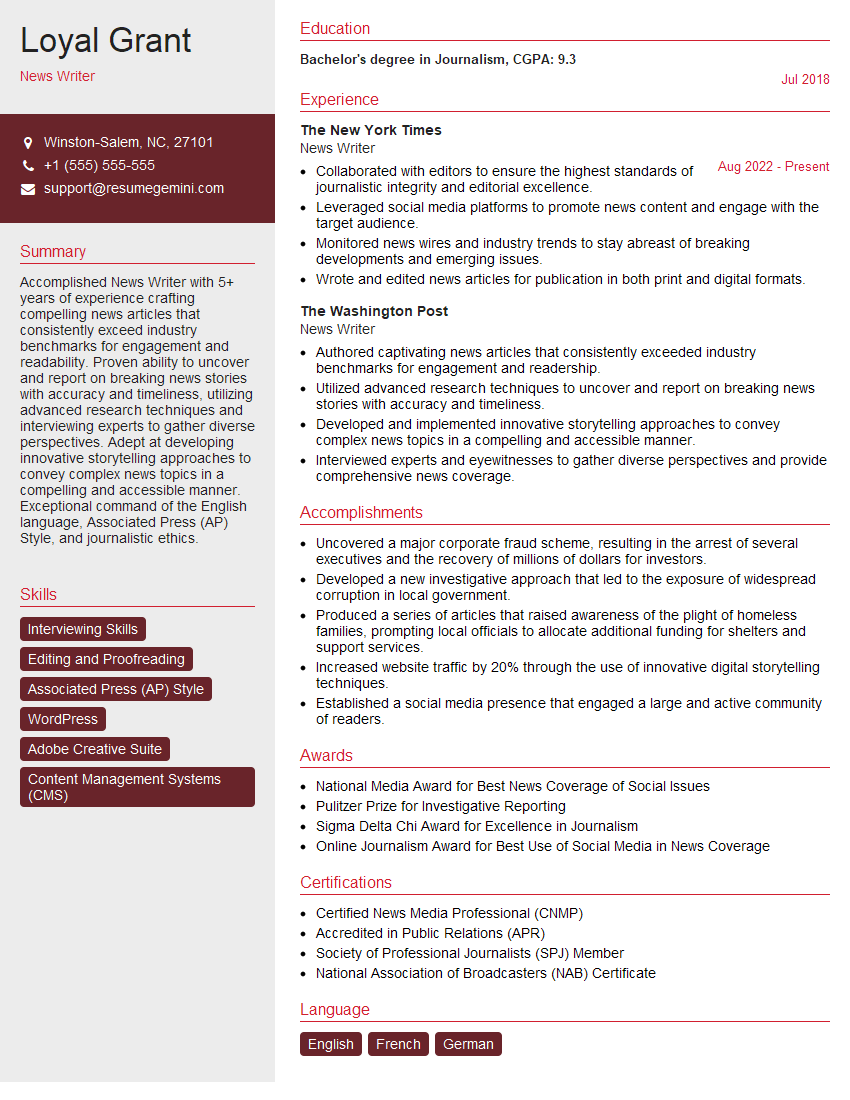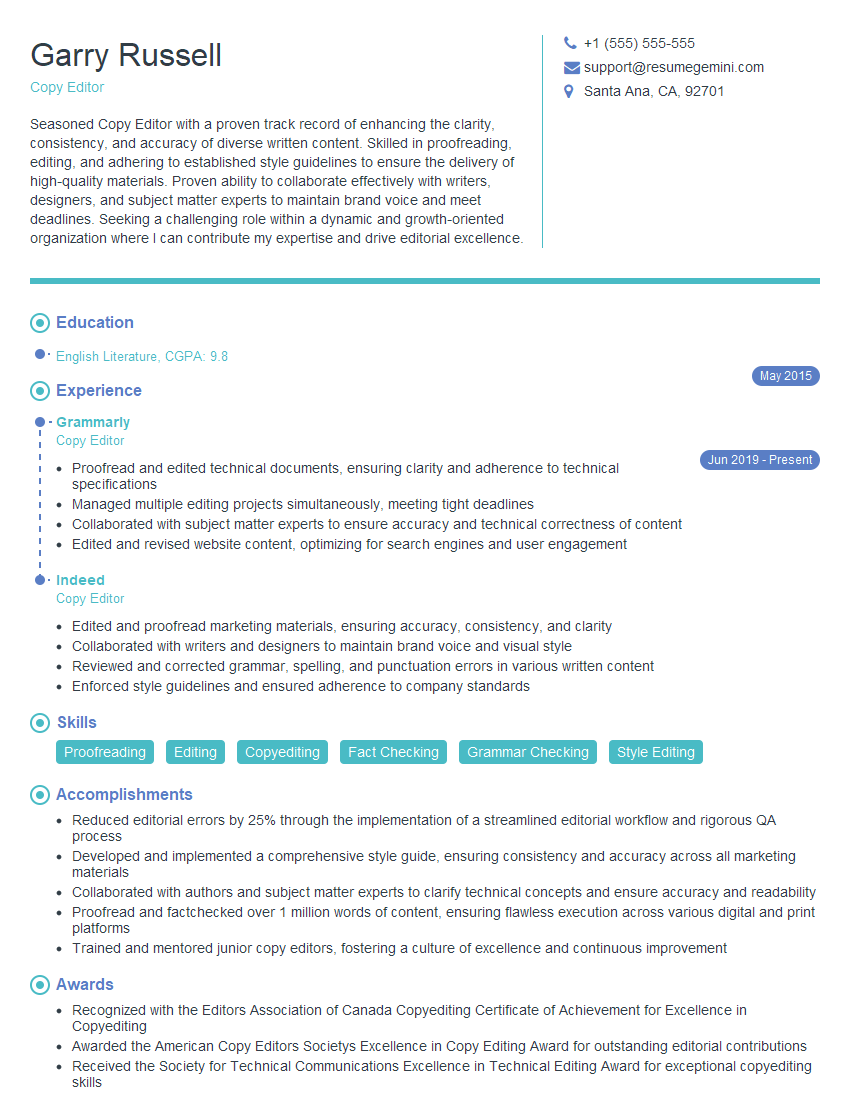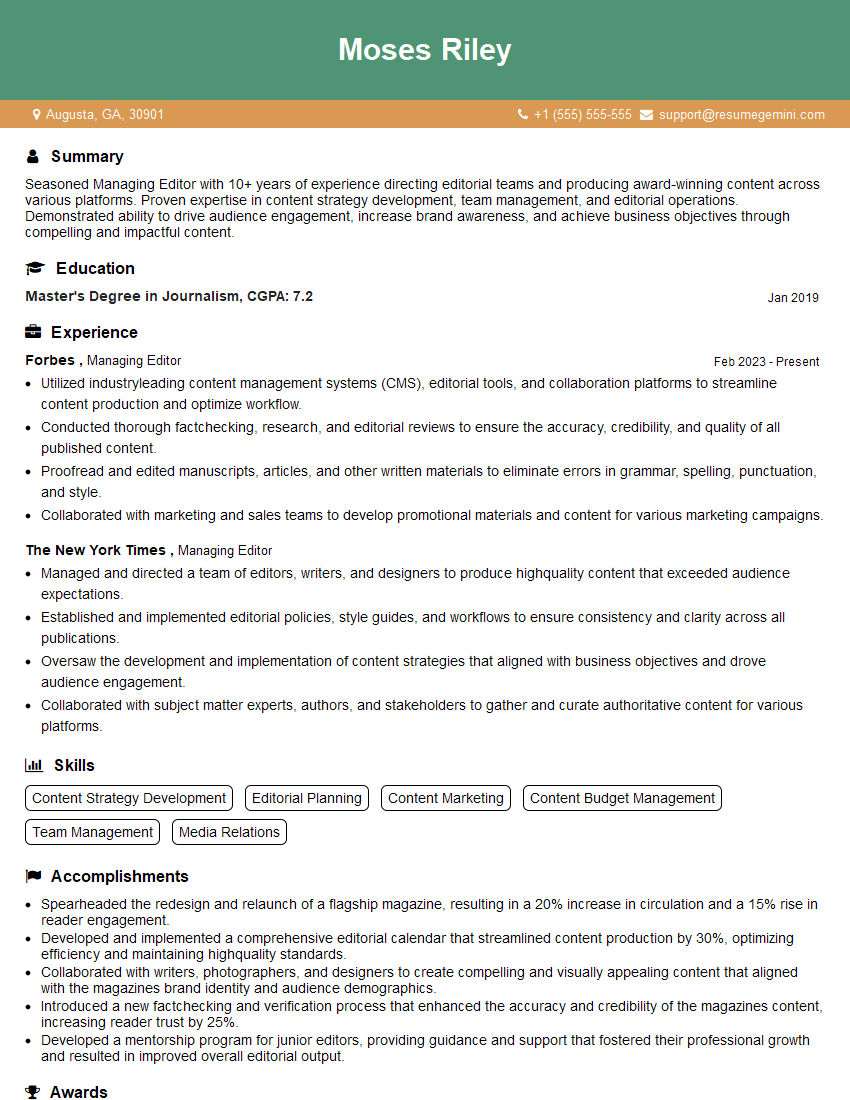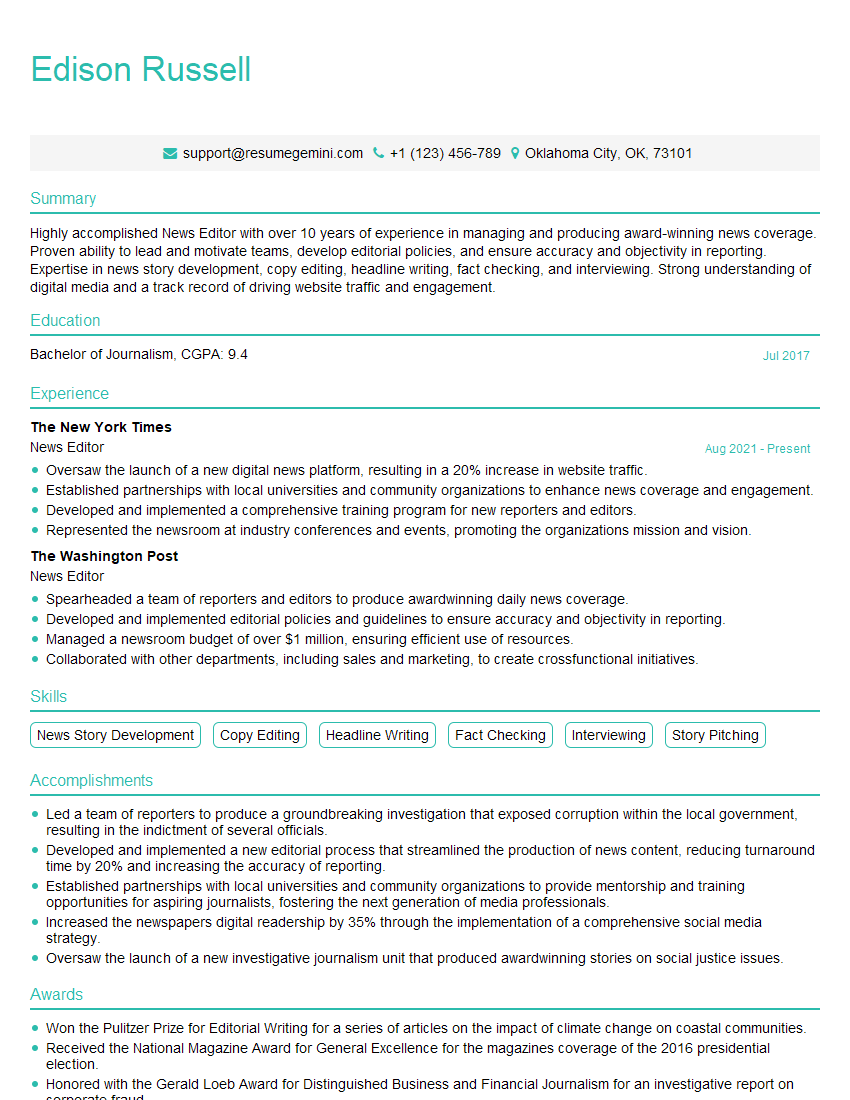Preparation is the key to success in any interview. In this post, we’ll explore crucial Newscasting interview questions and equip you with strategies to craft impactful answers. Whether you’re a beginner or a pro, these tips will elevate your preparation.
Questions Asked in Newscasting Interview
Q 1. Describe your experience in writing news scripts under tight deadlines.
Writing news scripts under tight deadlines is a core skill in broadcast journalism. It requires a combination of speed, accuracy, and clear thinking. My experience has honed this ability significantly. I’ve worked on breaking news stories where I had mere minutes to craft a concise, informative script based on rapidly evolving information. For example, during a major weather event, I had to synthesize information from multiple sources – weather reports, emergency services, and eyewitness accounts – and produce a script in under 10 minutes. This involved prioritizing key information, writing in short, declarative sentences, and focusing on the most impactful details.
My process usually involves:
- Rapid information gathering: Quickly absorbing key details from various sources.
- Concise writing: Focusing on brevity and clarity, avoiding jargon.
- Structure and flow: Organizing the information logically and ensuring a smooth narrative.
- Multiple drafts (when time allows): Refining the script for conciseness and impact.
The pressure is immense, but the reward of delivering timely and accurate information to viewers is incredibly satisfying.
Q 2. Explain your process for verifying the accuracy of information before broadcasting.
Verifying the accuracy of information is paramount in newscasting. It’s not just about reputation; it’s about public trust. My verification process involves multiple steps. It’s not enough to trust a single source; it requires triangulation of information.
- Multiple Source Verification: I always cross-reference information from at least two independent and reliable sources. If there are discrepancies, I investigate further to determine the most accurate account.
- Fact-checking: I carefully examine all facts and figures, checking dates, times, locations, and names. I use reputable fact-checking websites and databases whenever possible.
- Source Credibility Assessment: I evaluate the reliability and expertise of the sources. Is this person a credible expert or eyewitness? Do they have any potential biases?
- Contextualization: I ensure the information is presented within its proper context to avoid misrepresentation or misleading conclusions.
For example, if reporting on a company’s financial performance, I’d consult the company’s official reports, financial news outlets, and possibly independent financial analysts’ reports to ensure accuracy.
Q 3. How do you handle on-air mistakes or unexpected events during a live broadcast?
Handling on-air mistakes or unexpected events requires quick thinking, composure, and professionalism. The key is to recover gracefully and maintain the integrity of the broadcast. My approach involves:
- Immediate Correction (if possible): If it’s a minor error, I might discreetly correct it mid-sentence. For example, if I mispronounce a name, I would quickly and smoothly correct myself.
- Smooth Transition: If a mistake is more significant, I’d try to seamlessly transition to the next segment or piece of information, avoiding drawing attention to the error.
- Adaptability: If an unexpected event occurs (e.g., a breaking news alert), I need to quickly assess the situation and adjust the broadcast accordingly, prioritizing the most important information.
- Post-Broadcast Review: After the broadcast, I review the recording to identify areas for improvement and to learn from any mistakes made.
Think of it like navigating a ship in a storm. You don’t panic; you adapt to the changing conditions and keep the ship on course.
Q 4. Describe your experience working with different camera angles and lighting setups.
Working with different camera angles and lighting setups is a crucial aspect of visual storytelling in newscasting. My experience encompasses a wide range of scenarios, from studio broadcasts with multiple cameras and sophisticated lighting to field reporting with limited equipment.
Understanding camera angles is vital. A wide shot provides context, while a close-up focuses on emotion. I know how to work effectively with different camera operators, communicating clearly my intentions and adjusting my delivery accordingly. I understand how lighting impacts mood and clarity; good lighting is essential for a professional look. I’ve worked in environments with varying lighting conditions, adapting my positioning and presentation to ensure optimal visual quality. For instance, in a dimly lit interview setting, I’d consciously position myself to maximize the available light while remaining aware of shadows that could obscure my face.
Q 5. How familiar are you with news writing styles (AP, inverted pyramid)?
I am highly familiar with AP (Associated Press) style and the inverted pyramid structure of news writing. These are fundamental to broadcast journalism.
AP Style: This style guide dictates consistent writing conventions regarding punctuation, capitalization, numbers, and abbreviations. It ensures clarity and uniformity in news reporting. For example, AP style prefers “US” to “U.S.”
Inverted Pyramid: This structure prioritizes the most important information at the beginning of the story, followed by less critical details. This allows viewers to grasp the essence of the story quickly, even if the broadcast is interrupted.
Mastering these styles ensures the news is delivered concisely and accurately, following industry standards.
Q 6. What software or editing tools are you proficient in (e.g., Avid, Final Cut Pro)?
I am proficient in several newsroom software and editing tools. My expertise includes:
- Avid Media Composer: I’m highly skilled in using Avid for video editing, including cutting, assembling, and adding graphics and sound effects.
- Final Cut Pro: I am also experienced with Final Cut Pro, another industry-standard non-linear video editor, offering similar functionality to Avid.
- Adobe Premiere Pro: I am proficient with Adobe Premiere Pro, known for its robust features and versatility in video editing.
These tools enable me to efficiently edit video and audio, ensuring the final product meets broadcast standards in terms of quality and timing.
Q 7. How do you adapt your reporting style to different audiences or platforms?
Adapting reporting style to different audiences and platforms is essential for effective communication. My approach focuses on understanding the target audience and the specific requirements of the platform.
Audience: When reporting to a younger audience (e.g., social media), I use more informal language and shorter sentences. For older audiences, I might favor a more formal tone. For specialized audiences (e.g., business news), I use more technical terminology.
Platform: A news report for television needs to be concise and visually engaging, relying on strong visuals and clear, simple language. A news report for a newspaper article can be longer and more detailed. Radio requires a different approach again, relying primarily on audio cues and a strong narrative voice.
Essentially, it’s about tailoring my message to resonate effectively with the specific audience and platform while maintaining journalistic integrity.
Q 8. How do you maintain composure and professionalism under pressure?
Maintaining composure and professionalism under pressure in newscasting is paramount. It’s about years of training and practice, honing a skillset that allows you to remain calm and focused even in chaotic situations. This involves several key elements:
- Deep Breathing Techniques: Before going on air or during a particularly stressful moment, taking several slow, deep breaths can significantly reduce anxiety and help you regain control. Think of it like a mental reset button.
- Preparation and Rehearsal: Thorough research and rehearsal are crucial. Knowing your material inside and out builds confidence and minimizes the likelihood of unexpected stumbling blocks. This includes preparing for potential interruptions or difficult questions.
- Mental Reframing: Instead of viewing pressure as a negative, reframe it as a challenge. Focusing on delivering accurate and impactful information can shift your mindset towards a more positive and productive approach. Remind yourself why you are doing this; you’re informing the public.
- Experience: With time, you develop a resilience to pressure. The more live broadcasts, interviews, and breaking news situations you handle, the more comfortable you become in navigating the stressful aspects of the job.
For instance, during a live report on a major earthquake, I found myself unexpectedly interrupted by a loud aftershock. While startled initially, my years of experience kicked in. I took a deep breath, maintained eye contact with the camera, and continued the report as calmly and professionally as possible, providing essential information to viewers without showing panic.
Q 9. Describe your experience conducting interviews and obtaining sound bites.
Conducting interviews and obtaining sound bites is a core skill in newscasting. It requires a combination of preparation, active listening, and strong interpersonal skills. My experience involves:
- Pre-Interview Research: Before every interview, I thoroughly research the interviewee and the topic to formulate relevant and insightful questions. This allows me to engage in a more informed and meaningful conversation.
- Establishing Rapport: Building a comfortable environment helps interviewees relax and speak more openly. This involves clear communication, demonstrating respect for their time and views, even if you disagree.
- Active Listening: I focus intently on the interviewee’s responses, listening not only for the answers but also for subtle cues and unspoken information. This helps me formulate follow-up questions and keep the conversation flowing naturally.
- Strategic Questioning: I use a mix of open-ended and closed-ended questions to elicit detailed responses while also gaining concise sound bites. I learn to listen for the ‘gold’ in their answers – the nuggets of information perfect for broadcasting.
- Post-Interview Review: After the interview, I review the recording to identify the most compelling sound bites and ensure the information is accurate and unbiased.
For example, when interviewing a survivor of a natural disaster, I first focused on establishing a rapport by acknowledging their experience and expressing empathy. This helped them open up more readily, providing poignant soundbites that conveyed the human impact of the event.
Q 10. How do you prioritize multiple tasks and manage your time effectively in a fast-paced newsroom?
Time management in a fast-paced newsroom is critical. It’s a constant juggling act of multiple priorities and deadlines. My strategy involves:
- Prioritization: I use a combination of methods to prioritize tasks. I often use a to-do list, breaking down large tasks into smaller, manageable steps. I also utilize time-blocking techniques, allocating specific time slots for different tasks. Most importantly, I assess the urgency and importance of each task to ensure the most crucial are completed first.
- Planning and Organization: Daily planning and organization are essential. I often start my day by reviewing my schedule, prioritizing my tasks, and anticipating potential challenges. This allows me to proactively manage my time and allocate resources efficiently.
- Collaboration and Delegation: Working effectively with colleagues is vital. I delegate tasks where appropriate and collaborate on projects to share the workload and ensure a smoother workflow.
- Flexibility and Adaptability: Unexpected events are common in news. I’m prepared to adapt my plans and shift priorities based on breaking news or urgent developments. Flexibility and quick decision making are essential.
In a recent situation where I had to file a report, conduct a live interview, and write a news brief, all within an hour, my prioritized to-do list and efficient workflow enabled me to complete all tasks successfully.
Q 11. Describe a time you had to report on a sensitive or controversial issue.
Reporting on sensitive or controversial issues requires careful consideration and a commitment to ethical journalism. I recall reporting on a highly divisive local election where allegations of voter fraud surfaced. The situation was highly charged, with strong opinions on both sides. My approach involved:
- Thorough Fact-Checking: I meticulously verified all information, consulting multiple sources, and cross-referencing data to ensure accuracy. I contacted election officials, reviewed legal documents, and interviewed individuals from both sides of the issue.
- Neutral and Balanced Reporting: I presented the facts objectively, providing equal weight to different perspectives. I avoided using loaded language or making judgments. I focused on presenting all sides of the story, allowing viewers to form their own conclusions.
- Sensitivity and Respect: I handled the subject matter with sensitivity, avoiding inflammatory language or statements that could further polarize the community. I tried to find common ground and areas where people could come together.
- Transparency: I ensured transparency in my reporting methods, disclosing any potential conflicts of interest and acknowledging the limitations of the available information.
The resulting report was widely viewed as fair and informative, contributing to a more nuanced public understanding of a complex and controversial topic. The most important thing was that we gave the public enough information for them to make up their own minds.
Q 12. How do you ensure your reporting is unbiased and objective?
Ensuring unbiased and objective reporting is fundamental to journalistic integrity. This involves:
- Multiple Sources: I strive to use multiple sources of information whenever possible, verifying facts and perspectives from various angles. This helps reduce the risk of bias and presents a more comprehensive picture.
- Fact-Checking: Rigorous fact-checking is crucial. This includes verifying information through credible sources, checking statistics, and confirming details with multiple independent sources.
- Avoiding Loaded Language: I avoid using emotionally charged or biased language in my reporting. Instead, I use neutral and descriptive language that allows the facts to speak for themselves.
- Presenting Multiple Perspectives: When reporting on controversial issues, I strive to present different perspectives fairly and equally, avoiding taking sides or promoting a particular viewpoint.
- Self-Reflection and Awareness: Journalists should be aware of their own biases and actively work to mitigate their influence on their reporting. This includes seeking feedback from colleagues and editors to identify areas for improvement.
For instance, when reporting on a political debate, I made a conscious effort to present the key arguments from both sides, highlighting their policy proposals without injecting my own opinions or commentary.
Q 13. Explain your understanding of ethical considerations in news reporting.
Ethical considerations are paramount in news reporting. These include:
- Accuracy: The accuracy of information is paramount. Journalists have a responsibility to verify facts and correct errors promptly. We must avoid fabricating information or intentionally distorting the truth.
- Impartiality: News reporting should be impartial and objective. Journalists should strive to present information fairly, without bias or prejudice, allowing the public to draw their own conclusions.
- Fairness: Fairness requires that all sides of a story are given adequate consideration. People should be allowed to respond to accusations and criticism.
- Privacy: The privacy of individuals should be respected. Journalists should avoid disclosing sensitive information unnecessarily, particularly that which could endanger individuals or damage their reputation.
- Conflicts of Interest: Journalists should avoid situations that could create conflicts of interest. This includes disclosing any financial or personal relationships that could influence their reporting.
- Transparency: Transparency in reporting methods and sources ensures accountability. Transparency also helps maintain public trust.
In a recent case, when I was considering publishing a story involving a minor, I carefully reviewed the ethical guidelines to ensure the child’s identity and privacy were fully protected. It meant revising the story and withholding certain details to meet the ethical standards.
Q 14. How do you utilize social media to enhance news coverage?
Social media is a powerful tool for enhancing news coverage. My approach includes:
- Breaking News Updates: Social media platforms provide a rapid way to disseminate breaking news updates, allowing news organizations to quickly reach a wider audience. It’s crucial to be accurate in these updates, however, as corrections might not reach everyone as quickly as the initial update.
- Engaging with Audiences: Social media provides an opportunity to interact directly with audiences, gathering feedback and responding to queries. It builds a connection and helps understand viewers’ concerns.
- Sharing Multimedia Content: Social media allows for the sharing of diverse multimedia content (photos, videos, live streams) enriching the storytelling and engaging users visually.
- Expanding Reach: Social media expands reach, providing broader access to news and information, especially to demographics typically missed by traditional media.
- Promoting Stories: Social media platforms are effective tools for promoting important stories and investigations, ensuring wider dissemination and potential impact. Knowing the best platforms for the target audience is key.
During a recent major weather event, I used Twitter to provide live updates, photos, and videos from the field, connecting directly with viewers and offering information not available on traditional broadcasts. The real-time interaction boosted public awareness and improved our response to the unfolding situation.
Q 15. Describe your experience in live reporting from the field.
Live reporting from the field is the heart of broadcast journalism – it’s where the immediacy and impact of news truly come alive. My experience spans numerous high-pressure situations, from covering breaking news events like natural disasters and political rallies to conducting live interviews with key figures. I’ve learned to maintain composure under pressure, quickly assess situations, and deliver accurate and engaging reports even amidst chaos. For example, during a hurricane coverage, I had to adapt to rapidly changing conditions, ensuring my safety and maintaining clear communication with the studio despite power outages and communication disruptions. This involved using satellite phones, adapting to changing visual backdrops and keeping a calm voice to reassure viewers during a stressful situation. Another time, I interviewed a high-profile politician live from a crowded public space, requiring quick thinking to manage background noise and distractions while maintaining a professional and informative dialogue.
Career Expert Tips:
- Ace those interviews! Prepare effectively by reviewing the Top 50 Most Common Interview Questions on ResumeGemini.
- Navigate your job search with confidence! Explore a wide range of Career Tips on ResumeGemini. Learn about common challenges and recommendations to overcome them.
- Craft the perfect resume! Master the Art of Resume Writing with ResumeGemini’s guide. Showcase your unique qualifications and achievements effectively.
- Don’t miss out on holiday savings! Build your dream resume with ResumeGemini’s ATS optimized templates.
Q 16. How familiar are you with different microphone types and their applications?
Microphone selection is crucial for quality sound. I’m proficient with various types, including lavalier microphones (small, clipped-on mics ideal for interviews), handheld microphones (versatile for speeches or field reporting), shotgun microphones (directional, capturing sound from a specific area, minimizing background noise), and wireless microphones (offering mobility during live events). Understanding their applications is key; for instance, a lavalier mic is preferred for an interview to keep the reporter’s hands free and maintain a natural conversation, whereas a shotgun mic is essential for capturing clear audio from a distance at a noisy demonstration. I always consider the environment and the desired outcome when choosing a microphone – the wrong choice can severely impact audio quality and the overall effectiveness of the report.
Q 17. How do you handle conflicting deadlines and competing priorities?
Newsrooms are often juggling multiple deadlines and competing priorities. My strategy involves prioritizing tasks based on their urgency and impact. I utilize time management techniques like creating detailed schedules, breaking down large tasks into smaller, manageable steps, and effectively communicating with colleagues to ensure everyone is on the same page. For example, if I’m working on a major breaking news story with a tight deadline while simultaneously needing to prepare a segment for a later newscast, I’ll dedicate focused blocks of time to each, employing a rapid writing and editing style for the urgent story and leaving more time for polish and detailed production for the later segment. Clear communication with producers and editors is essential for effectively allocating time and resources.
Q 18. Describe your experience in using teleprompters.
Teleprompters are an invaluable tool for delivering smooth, well-paced newscasts. My experience includes using various teleprompter systems and software, mastering the ability to read naturally and convincingly while maintaining eye contact with the camera. I’m proficient in adjusting the scrolling speed to match my delivery pace and can readily adapt to technical issues or unexpected changes in the script. The key is practice – the more familiar you are with the system and your script, the more natural your delivery will be. This includes familiarizing yourself with the teleprompter’s functionality, the script’s content, and practicing delivery at different speeds and tones. I’ve developed a strong ability to engage the audience even while reading from the teleprompter, making the broadcast personable and trustworthy.
Q 19. What is your preferred method for gathering news information?
My preferred method for gathering news information is multi-faceted and relies on a combination of approaches. I start with thorough research utilizing reputable news sources, government databases, and academic journals. Then, I engage in direct sourcing through interviews with individuals directly involved in the story, seeking diverse perspectives to present a balanced and nuanced perspective. Social media monitoring plays a role in detecting developing stories and identifying potential sources. Fact-checking is integral to the process, cross-referencing information and verifying its accuracy from multiple credible sources. Finally, the most crucial aspect is always maintaining journalistic ethics and principles throughout the entire process.
Q 20. How would you handle a situation where your source is unreliable?
Dealing with unreliable sources is a common challenge in journalism. My approach involves verifying information rigorously through multiple independent sources. If a source’s information cannot be corroborated, I will either not use it or clearly indicate the uncertainty surrounding that particular piece of information. Transparency is crucial; if I am uncertain about a source’s reliability, I will mention that in my report, allowing viewers to form their own informed opinion. Documenting my sourcing efforts is also key; if a source proves to be false or misleading, I must be able to show where my investigation went wrong and why the mistake was made.
Q 21. What strategies do you use for effective storytelling in news reports?
Effective storytelling in news is about connecting with the audience on an emotional level while delivering factual information. I employ several strategies, including focusing on human interest elements to make the story relatable and engaging. I use strong visuals and compelling audio to enhance the narrative and create a memorable experience. Constructing a clear narrative arc – with a beginning, middle, and end – guides the audience through the story effectively. Careful selection of quotes and soundbites can bring the story to life and highlight key themes. Ultimately, it’s about finding the right balance between factual reporting and emotional engagement to resonate with the viewers and convey the essence of the story.
Q 22. How do you build rapport and trust with interviewees?
Building rapport and trust with interviewees is paramount for a successful newscast. It’s about creating a safe and comfortable environment where they feel heard and respected. This starts before the interview even begins.
- Pre-Interview Communication: I always reach out beforehand, not just to schedule, but to briefly discuss the topic and any concerns they might have. This allows me to tailor my questions and approach to their individual needs and communication style. For example, if I’m interviewing someone who has experienced a traumatic event, I’ll be particularly sensitive and empathetic in my approach, focusing on their experience and ensuring they feel in control of the narrative.
- Active Listening: During the interview, active listening is key. This means paying close attention not only to their words but also their body language. I show genuine interest by making eye contact, nodding, and offering small verbal cues like ‘uh-huh’ or ‘I understand’. This creates a sense of connection and assures them they are being heard.
- Empathy and Respect: I always treat interviewees with respect, regardless of their background or viewpoint. Even if I strongly disagree with their opinions, I aim to understand their perspective and convey that understanding in my questions and responses. I’ve found that fostering a feeling of mutual respect leads to more open and honest conversations.
- Transparency: Being upfront about the purpose of the interview and how the information will be used builds trust. I always clearly explain the context of the piece and any potential limitations, such as time constraints or the need to edit for clarity. Honesty builds trust, whereas obfuscation breeds suspicion.
Ultimately, building rapport is about creating a human connection, putting the interviewee at ease, and letting their personality and story shine through. This leads to more insightful and compelling interviews, benefiting both the interviewee and the audience.
Q 23. How do you stay informed about current events and industry trends?
Staying informed in the fast-paced world of news requires a multi-faceted approach. It’s not just about reading headlines; it’s about critical engagement with diverse sources.
- Reputable News Sources: I subscribe to a range of reputable news organizations, both domestic and international, to get a comprehensive picture of current events. This includes print publications, online news sites, and respected broadcast networks. I pay close attention to how different news outlets frame the same story, looking for biases and diverse perspectives.
- Industry Publications and Blogs: I regularly read industry-specific publications and blogs that focus on journalism ethics, broadcast technology, and news trends. This keeps me up-to-date on the latest innovations and best practices within my profession. For example, staying current on changes in social media reporting and ethical dilemmas related to online news is crucial.
- Social Media Monitoring: While social media needs careful scrutiny, it can provide valuable real-time information and insights. I use social media cautiously, verifying information from multiple sources before accepting it as credible. I often use it to monitor public sentiment on breaking news stories.
- Networking and Professional Development: I actively participate in professional development activities, attending conferences and workshops, and connecting with other journalists through industry networks. These interactions expose me to new ideas, insights, and perspectives.
This holistic approach ensures that I am well-informed, not only about the day’s headlines, but also about the broader context and evolving landscape of news and broadcasting.
Q 24. Describe your experience with newsroom technology and workflow.
My experience encompasses a wide range of newsroom technologies and workflows, from traditional broadcast equipment to the latest digital platforms.
- Traditional Broadcast Equipment: I am proficient in operating and maintaining studio cameras, teleprompters, audio mixers, and other traditional broadcast equipment. I understand the importance of maintaining a clean, crisp audio and video signal.
- Digital News Gathering (DNG) and Editing Software: I’m experienced in using various DNG tools and video editing software, such as Adobe Premiere Pro and Avid Media Composer, to capture, edit, and package news stories efficiently. My skills include shooting and editing video packages, incorporating graphics, and adding voice-overs.
- Newsroom Computer Systems (NRCS): I am familiar with various NRCS platforms for scheduling, story assignments, and managing workflow within a fast-paced newsroom environment. I understand the importance of deadlines and collaboration in producing timely and accurate news.
- Social Media Integration: I understand the importance of integrating social media into the newsgathering and dissemination process. This includes using social media to monitor events, gather information, and engage with audiences, always while maintaining journalistic ethics.
My experience allows me to seamlessly integrate into a newsroom workflow, contributing to the efficient and effective production of high-quality news programs. I’m also a quick learner and adapt easily to new technologies.
Q 25. What are your strengths and weaknesses as a newscaster?
As a newscaster, my strengths lie in my ability to deliver information clearly, concisely, and engagingly.
- Strong Communication Skills: I possess excellent verbal communication skills, a calm and confident on-air presence, and the ability to connect with viewers on an emotional level. I can adapt my delivery to suit different types of stories and audiences.
- Quick Learning and Adaptability: The news world is dynamic, so adaptability is key. I quickly grasp new information, adapt to changing circumstances, and learn new technologies rapidly.
- Impeccable Accuracy and Attention to Detail: Accuracy is paramount in newscasting. I meticulously fact-check information and maintain a high level of attention to detail, both in my delivery and the stories I present.
However, like all professionals, I’m always striving to improve. One area I’m actively working on is further developing my skills in live reporting from the field. Although I’m proficient in studio broadcasting, gaining greater experience in live on-site reporting is a key goal for my continued professional growth.
Q 26. Why are you interested in this specific newscasting position?
I’m particularly interested in this newscasting position because it aligns perfectly with my career aspirations and the values of your news organization.
- [Organization’s Reputation]: I’ve been deeply impressed by [Organization’s Name]’s commitment to [Mention a specific value, e.g., investigative journalism, community engagement, fair and unbiased reporting]. This resonates strongly with my own professional ethics.
- [Specific Role Responsibilities]: The opportunity to [Mention a specific aspect of the role that excites you, e.g., work with a specific team, cover particular areas of interest, utilize cutting-edge technology] is particularly appealing. This would allow me to leverage my skills and contribute meaningfully to your team.
- [Growth and Development]: I see significant growth potential within this role and the organization as a whole. The opportunity to learn from experienced professionals and contribute to a team dedicated to excellence is a highly motivating prospect.
I believe my skills and experience make me a strong candidate to excel in this role and contribute to the continued success of [Organization’s Name].
Q 27. What are your salary expectations?
My salary expectations are in line with the industry standard for a newscaster with my experience and qualifications in this market. I am flexible and open to discussing this further based on the details of the compensation package and the overall benefits offered.
Q 28. Do you have any questions for me?
Yes, I have a few questions. First, can you elaborate on the specific technologies used in your newsroom? Secondly, what opportunities are there for professional development and advancement within the organization? Finally, could you describe the typical day-to-day responsibilities of this position in more detail?
Key Topics to Learn for Newscasting Interview
- News Gathering and Verification: Understanding the journalistic process, including source verification, fact-checking, and ethical considerations. Practical application: Demonstrate your ability to assess the credibility of information sources and explain your process for verifying facts.
- Scriptwriting and Storytelling: Crafting concise, engaging news scripts that are clear, accurate, and impactful. Practical application: Prepare examples of scripts you’ve written, demonstrating your ability to adapt your writing style to different news formats (e.g., breaking news, features).
- On-Camera Delivery: Mastering vocal delivery, body language, and eye contact to effectively communicate information to the audience. Practical application: Practice delivering news scripts while maintaining composure and professional demeanor. Consider recording yourself and analyzing your performance.
- News Presentation Styles: Familiarity with various news formats (hard news, soft news, features, etc.) and adapting your presentation style accordingly. Practical application: Be prepared to discuss examples of different news presentation styles and explain how you would adjust your approach depending on the story.
- Technical Aspects: Understanding basic broadcast technology, including teleprompters, microphones, and cameras. Practical application: Demonstrate a basic understanding of broadcast equipment and your ability to troubleshoot minor technical issues.
- Current Events Awareness: A deep understanding of current national and international news. Practical application: Be prepared to discuss recent significant events and their implications.
- Interviewing Techniques: Conducting effective interviews with sources, asking insightful questions, and obtaining relevant information. Practical application: Be ready to describe your interviewing style and how you build rapport with interviewees.
Next Steps
Mastering newscasting skills significantly enhances your career prospects, opening doors to exciting opportunities in broadcast journalism and related fields. A strong, ATS-friendly resume is crucial for getting your foot in the door. To create a compelling and effective resume that highlights your skills and experience, we highly recommend using ResumeGemini. ResumeGemini provides tools and resources to build a professional resume, and examples of resumes tailored to Newscasting are available to help guide you.
Explore more articles
Users Rating of Our Blogs
Share Your Experience
We value your feedback! Please rate our content and share your thoughts (optional).
What Readers Say About Our Blog
Dear Sir/Madam,
Do you want to become a vendor/supplier/service provider of Delta Air Lines, Inc.? We are looking for a reliable, innovative and fair partner for 2025/2026 series tender projects, tasks and contracts. Kindly indicate your interest by requesting a pre-qualification questionnaire. With this information, we will analyze whether you meet the minimum requirements to collaborate with us.
Best regards,
Carey Richardson
V.P. – Corporate Audit and Enterprise Risk Management
Delta Air Lines Inc
Group Procurement & Contracts Center
1030 Delta Boulevard,
Atlanta, GA 30354-1989
United States
+1(470) 982-2456
